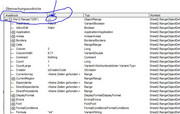Results1 Single Cell in out of Evaluate( ).JPG
Results 1 Single Cell in/ out of Evaluate(" ")
Evaluate(" ") works a bit differently for a range.
It appears initially to return a range object. Put that in a cell via like
Range( "GH45").Value = That range object
, in the development coding example, B51 or A52, (and A56 or B56), or like in the macro below, and you will get that Number held as text thing preserved when that range object is “put in the cell” via like
Range( "GH45").Value = That range object
Otherwise you are not going to get the preservation directly via Evaluate(" ") . You would need to do some extra work to get the Value in a string element type array (of one element)Code:Sub SetRangeValueWithRange() Dim Ws12 As Worksheet: Set Ws12 = ThisWorkbook.Worksheets.Item("Sheet1 (2)") Let Ws12.Range("A50:D50").Value = Split("44 55 66 77") Dim CelRng As Range Set CelRng = Ws12.Range("A50") Let Ws12.Range("A60").Value = CelRng ' Gives Number held as text thing Let Ws12.Range("B60").Value = CelRng.Value ' does not give " ' https://i.postimg.cc/MTw4jdpV/Set-Ra...text-thing.jpg ' https://i.postimg.cc/rm9HGxDb/Set-Ra...text-thing.jpg '
End Sub
Saying something similar: Evaluate(" ") on a single cell range, like Evaluate("=G5") returns a range object of one cell. Depending on what type of variable you try to assign it to, it will coerce to all but an array. ( It will allow you to assign it to an element of an array, that array must be a variant or Range type. Applying to a Variant … lets look again at the measurements, Results, conclusions with hindsight in the next post…
.
..
https://www.youtube.com/channel/UCnxwq2aGJRbjOo_MO54oaHA
https://www.youtube.com/watch?v=ySENWFIkL7c
https://www.youtube.com/watch?v=ySENWFIkL7c&lc=UgyqIYcMnsUQxO5CVyx4AaABAg
https://www.youtube.com/watch?v=yVgLmj0aojI
https://www.youtube.com/watch?v=yVgLmj0aojI&lc=UgwWg8x2WxLSxxGsUP14AaABAg.9k3ShckGnhv9k89Lsaig oO
https://www.youtube.com/watch?v=yVgLmj0aojI&lc=UgxxxIaK1pY8nNvx6JF4AaABAg.9k-vfnj3ivI9k8B2r_uRa2
https://www.youtube.com/watch?v=yVgLmj0aojI&lc=UgxKFXBNd6Pwvcp4Bsd4AaABAg
https://www.youtube.com/watch?v=yVgLmj0aojI&lc=Ugw9X6QS09LuZdZpBHJ4AaABAg
https://www.youtube.com/watch?v=vXyMScSbhk4
https://www.youtube.com/watch?v=vXyMScSbhk4&lc=UgynOSp1dleo-Z8L_QN4AaABAg.9jJLDC1Z6L-9k68CuL4aTY
https://www.youtube.com/watch?v=vXyMScSbhk4&lc=UgwV5N_ulFXYMNbyQG54AaABAg.9itCkoVN4w79itOVYVvE wQ
https://www.youtube.com/watch?v=vXyMScSbhk4&lc=UgyOh-eR43LvlIJLG5p4AaABAg.9isnKJoRfbL9itPC-4uckb
https://www.youtube.com/watch?v=vXyMScSbhk4&lc=Ugy1B1aQnHq2WbbucmR4AaABAg.9isY3Ezhx4j9itQLuif2 6T
https://www.youtube.com/watch?v=vXyMScSbhk4&lc=UgxxajSt03TX1wxh3IJ4AaABAg.9irSL7x4Moh9itTRqL7d Qh
https://www.youtube.com/watch?v=vXyMScSbhk4&lc=Ugxa2VYHMWJWXA6QI294AaABAg.9irLgSdeU3r9itU7zdnW Hw
https://www.youtube.com/watch?v=vXyMScSbhk4&lc=UgwJAAPbp8dhkW2X1Uh4AaABAg.9iraombnLDb9itV80HDp Xc
https://www.youtube.com/watch?v=vXyMScSbhk4&lc=UgzIzQ6MQ5kTpuLbIuB4AaABAg.9is0FSoF2Wi9itWKEvGS Sq
https://www.youtube.com/channel/UCnxwq2aGJRbjOo_MO54oaHA









 Reply With Quote
Reply With Quote







Bookmarks